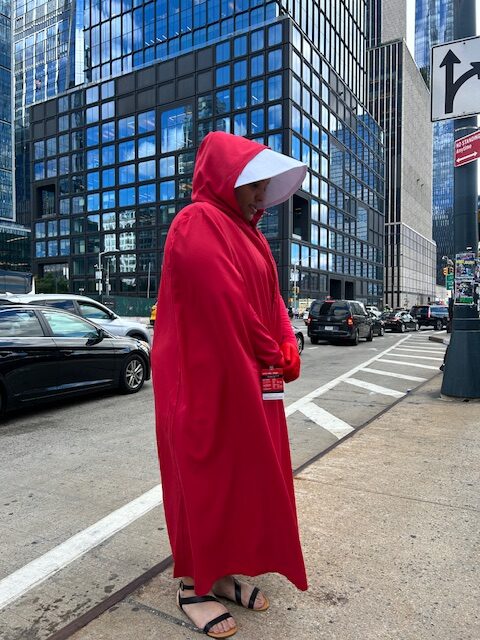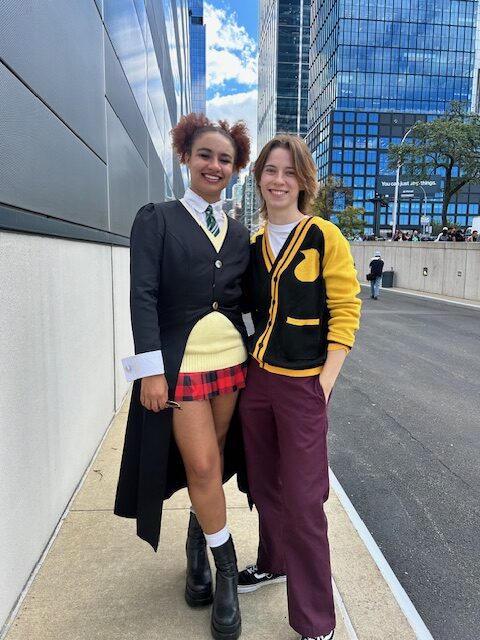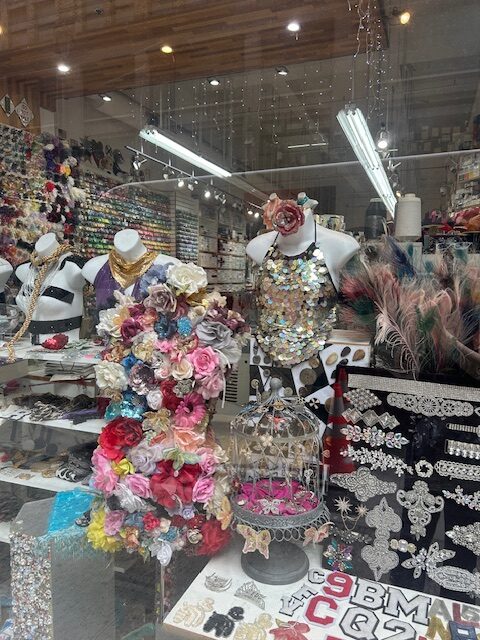Spider-Man, Batman, and Deadpool share a cigarette together in Midtown. Supposedly off-duty heroes, they greet Chainsaw Man and Chun-Li passing by. K-pop Demon Hunters girl group Huntrix makes an appearance, brandishing makeshift swords and glittered diva outfits, and Arcane’s Jinx shouts to her twin as the sun glints off her crafted rocket launcher. “Is it Halloween?” a pedestrian asked on the street. No, it’s the weekend of the largest fan convention in the nation, New York Comic Con. With over 200,000 attendees in recent years of comic book fans, anime lovers, and TTRPG (table top role-play game) dice rollers, there’s a niche for just about anyone.
A red-cloaked figure weaving silently through the crowd sticks out starkly amongst the Marvel heroes and anime characters. Angie Bejar is cosplaying as a handmaid from “The Handmaid’s Tale,” Margaret Atwood’s novel turned TV show. While some fans cosplay to connect with fellow enthusiasts, others, like Bejar, use cosplay for political self-expression, exemplifying intersectional identities with fictional representation, values that resonate for many in the upcoming mayoral race. Bejar chose this cosplay because “we’re already living in a dystopian future. So that’s why I wore this because I’m also a mom, but it was by choice, and some people don’t have the choice.”
Bejar adorned the oppressive red cloak to share a powerful statement about pro-choice policies and to increase awareness around child brides in America, as these issues are important to her when she casts her vote for NYC’s mayor in November. Expressing dislike for both Cuomo and Adams, she said, “I like where Mamdani is going, although I still, just like everybody else, have questions where the money’s gonna come from, where he wants to do certain things that past mayors didn’t get to do.” She especially likes Mamdani’s educational reform ideas and overhaul of standardized testing and gifted programs for students under age five, which she is passionate about as a mother.
A mother to her 13-year-old son, they share in the joy of fandom communities, like Disney, together. She sees how fandoms can provide close knit communities and wants to show her son that anyone can cosplay any fictional character they want. “We can’t cosplay a lot of the things we want to cosplay because they say it’s too white, or it’s not Japanese enough, or it’s always something,” Bejar said, when referring to her frustration at the historical difficulty of minorities being “gatekept” or barred from cosplaying certain characters. “A character is just a character. It’s actually fiction, you know, like, sorry, it’s personal. It’s not real. Anybody can be that character.”
Bejar’s identity intersects many different communities: people of color, people on the spectrum, people with disabilities. But she dislikes the labels associated with these groups. “I’ve always had labels put on to me before I was even born because my family is of mixed race,” she said outside the convention. “Some of them are Latino, some identify as Latin or Latin X, or Spanish, also, we have Caucasian, Black….so it’s hard to label myself one thing, but also at the same time, I don’t like the labels because I’ve been labeled since I was a newborn.”
For her, it’s especially important, but difficult, for her voice to be heard politically. She cares about education and women’s rights, but worries that, “it’s not my voice that actually matters because I am a person of color.” She wants to cast labels aside and, instead, said she just identifies as human, above all else. “That is the social construct of itself, about race and all that, where we come from, even though we should all be the human race, all human. We could connect on that level,” Bejar concluded.
These personal connections extend to many other communities at comic con, which 21-year-olds Jojo Collins and partner Phi Oeschger relate to deeply. With excited interest in fandoms like “Interview with a Vampire,” League of Legends, and Dungeons and Dragons, they cosplayed characters from the anime Soul Eater, wanting to not only connect with other fans but seek people with shared values, and find it representative in the mayoral candidates. “Intersectionality is huge to me, because I fall under a lot of different identities,” said Collins. “I’m Black and white, and I’m also a transmasc person and gender nonconforming, so it’s really important to me to find people that understand that or know that.”
They are both voting for Mamdani this November as they said his genuine and truthful demeanor represents “true New Yorkers,” and they support his policies that promote affordability and low-income support initiatives. They both study acting at the Marymount Manhattan College and care about issues that affect everyday New Yorkers, including diversity initiatives, reflected by the noticeable increased representation in fandoms, like Miles Morales, the first Black Spider-Man from “Spider-Man: Into the Spider-Verse.”

Collins and Bejar aren’t the only ones seeking intersectional and diverse representation across comics and fandom communities at the convention. “We tend to think of comic book nerds as suburban white kids, but actually New York Comic Con really serves an incredibly diverse group of people, Black and Latino and Asian, and every religion and every possibility,” said Johnathan Gray, Associate Professor of English at John Jay College-CUNY, author of the entry “Race” for Keywords for Comics Studies and currently writing a book project titled “Illustrating the Race: Representing Blackness in American Comics.”
Also present at the con, Gray saw cross-cultural celebration and the impact comics have on different communities. “In my professional opinion, Comic-Con is incredibly important, incredibly vibrant,” he said. “It serves an incredibly diverse community, people who are starving for representation, and we see that more so in places like Artist’s Alley.”
He spoke with a Korean-American illustrator, Greg Pak, whose Filipino superhero, Wave, connected to two NYU undergraduate students, including one Filipino student who was incredibly happy with the representation. Pak spoke on the “Filipino CNN” news channel about his character that, while not mainstream, made a profound impact on these two students. “His individual desire to represent the fullness of the Asian diaspora wound up reverberating, not just to the individual student, but also to the news in the Philippines,” noted Gray, who witnessed the interaction.
Comic Con is also embracing diverse superhero communities with a panel on Friday night titled “Salaam Fandom! Muslim Gamers, Creators, and Cosplayers” that will focus on Muslim representation in the industry. The panel’s timeliness comes as mayoral candidate Mamdani makes history as NYC’s first Muslim-American nominee, and whose wife, Rama Duwaji, is an animator and illustrator. The panel shows the desire, and need, for diverse panels that showcase different cultures, as “these people are finding, they’re sort of seeking, each other out and finding community through this medium,” said Gray.
New York Comic Con is not only a safe haven for the intersection of different communities and groups but also for some non-profits who want to connect with creative, like-minded people to share their cause. Abby Ascension works for a non-profit organization for ending child poverty and canvasses at cons because people are typically friendly and approachable. “People come to conventions to spend money, so why not spend money by helping some kids get out of poverty?” she said.
Comics and fandoms have also made a large impact in shaping Abby’s identity. She has two tattoos inspired by “Avatar: the Last Airbender,” and appreciates the diversity of the show’s sequel, “Legend of Korra,” which she said influenced her sense of self. “It’s very heavily inspired by Asian culture and Native American culture and I’m Asian,” she said. “‘Korrasami’ helped me realize that I was bisexual.”
‘Korrasami,’ is the relationship name for Korra and Asami, one of Nickelodeon’s first canon main character same-sex couples, confirmed in 2014, one year before gay marriage was legalized in the US. Living in NYC for two years now, she’s also voting for Mamdani for his stances on affordability, women’s rights, and access to Planned Parenthood, as well as better transportation accessibility she hopes to see improve.
Abby’s voting sentiments are echoed by another comic con attendee, Sandrine Saint Louis, a 32-year-old Black woman from Brooklyn cosplaying streetfighter Chun-Li. Saint Louis works for an arts non-profit organization as manager of mural operations, and is a Mamdani supporter for “the way that he’s relatable to the people, the way he speaks about how he knows that affordable housing is just really s— as of now,” she said. “To even get placement in the lottery system, the way he just speaks about how he wants to do better for us and anything that has nothing to do with Trump, it really just warms the heart.”
Saint Louis wants more affordable housing, cleaner streets, and more pedestrian-friendly forms of transportation available in NYC. She also wants to see diversity represented in comics and her fandoms, but admits representation has improved from when she was growing up. For right now, “even though it feels really great to be represented…I’m not necessarily going into it feeling like I got to see my people, because I just love the creation of things,” she said.
Time and again, the influence of comics and fictional characters permeates and crosses intersectional boundaries, connecting communities and collectively reminding us what it means to be human. Inspiration is threaded through so many comic book stories: “He’s not a god on earth,” said non-profit canvasser Archie Archuletta about one of his favorite superheroes, Spider-Man. “He’s a very grounded, average Joe who has an opportunity to help others, and that has always inspired me, inspires me to do what I do.”
From all the communities that gathered at New York Comic Con, it’s clear the convention is not just for “white, suburban kids.” “Fandoms come together and then they push stuff and they make things happen,” said Bejar. “I kind of wish everybody was like that, political wise.” New York Comic Con is for everyone, and ahead of the mayoral election, is a reminder of the powerful impacts created by crossing identities and political boundaries in fiction and real life.


